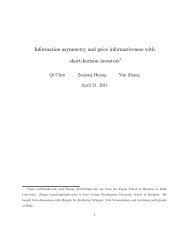Does Enforcement of Intellectual Property Rights Matter in China ...
Does Enforcement of Intellectual Property Rights Matter in China ...
Does Enforcement of Intellectual Property Rights Matter in China ...
You also want an ePaper? Increase the reach of your titles
YUMPU automatically turns print PDFs into web optimized ePapers that Google loves.
To test our hypotheses, we utilize several unique data sets that have not been exam<strong>in</strong>ed <strong>in</strong><br />
previous empirical studies. The database compiled by the M<strong>in</strong>istry <strong>of</strong> Science and Technology <strong>of</strong><br />
Ch<strong>in</strong>a (MOST) provides firm-level f<strong>in</strong>ancials and R&D related <strong>in</strong>formation for a large number <strong>of</strong><br />
Ch<strong>in</strong>ese high tech companies. These firms are unlisted companies. We choose to focus on these<br />
firms for the follow<strong>in</strong>g reasons. First, the success <strong>of</strong> high tech firms critically depends on the output<br />
from R&D and the legal protection <strong>of</strong> their exclusive rights. Second, listed firms <strong>in</strong> Ch<strong>in</strong>a are not<br />
required to disclose detailed <strong>in</strong>formation on their R&D activity, while our database <strong>of</strong> unlisted firms<br />
provides richer details, from R&D expenditure to R&D personnel composition. Third, s<strong>in</strong>ce unlisted<br />
firms are unable to raise funds from the stock market, the f<strong>in</strong>anc<strong>in</strong>g <strong>of</strong> their R&D activity is <strong>of</strong><br />
particular <strong>in</strong>terests.<br />
The enforcement <strong>of</strong> <strong>in</strong>tellectual property rights is many faceted. We <strong>in</strong>troduce two measures <strong>of</strong><br />
IP rights enforcement. The first is the fraction <strong>of</strong> <strong>in</strong>tellectual property <strong>in</strong>fr<strong>in</strong>gement cases won by the<br />
pla<strong>in</strong>tiffs <strong>in</strong> each prov<strong>in</strong>ce, thereafter labeled as “IPP1”. It directly measures the probability <strong>of</strong><br />
w<strong>in</strong>n<strong>in</strong>g by the pla<strong>in</strong>tiffs <strong>in</strong> IP <strong>in</strong>fr<strong>in</strong>gement cases, and thus a good proxy for the enforcement <strong>of</strong> IP<br />
rights <strong>in</strong> the courts. The second is the number <strong>of</strong> articles that advocate IP protection <strong>in</strong> the <strong>of</strong>ficial<br />
newspaper published by prov<strong>in</strong>cial Communist Party, thereafter labeled as “IPP2”. This variable<br />
conveys the IP enforcement policy from top prov<strong>in</strong>cial <strong>of</strong>ficials to all levels <strong>of</strong> local adm<strong>in</strong>istrative,<br />
judicial, and law enforcement agencies, s<strong>in</strong>ce these local <strong>of</strong>ficials are <strong>in</strong>variably Party members.<br />
The first measure <strong>of</strong> IP rights enforcement exam<strong>in</strong>es how well a prov<strong>in</strong>ce enforces laws and<br />
regulations on <strong>in</strong>tellectual properties via its court system. The court is an <strong>in</strong>tegral part <strong>of</strong> the IP<br />
rights enforcement, where it can order the defendant to cease <strong>in</strong>fr<strong>in</strong>gement, compensate the pla<strong>in</strong>tiff,<br />
or destroy the confiscated products. We collect the outcomes <strong>of</strong> IP <strong>in</strong>fr<strong>in</strong>gement cases brought<br />
5



